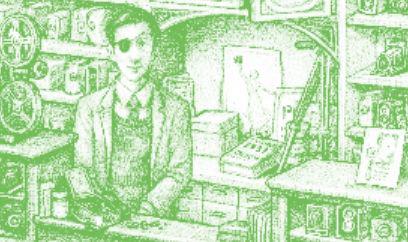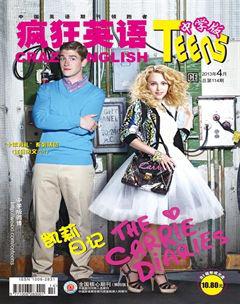凯迪克奖——绘本界的盛宴
by Lynn Neary
凯迪克奖是美国最具权威的绘本奖,今年1月迎来了75周年纪念。凯迪克奖是为了纪念十九世纪英国绘本画家伦道夫·凯迪克(Randolph Caldecott)而设立的。该奖之所以能够获得一致推崇,主要在于其评选标准着重作品的艺术价值和特殊创意,尤其每一部得奖作品都必须有“寓教于乐”的功能,让孩子在阅读的过程中开发另一个思考空间。
今年的获奖作品是乔恩·克拉森(Jon Klassen)的《这不是我的帽子》(This Is Not My Hat)。有兴趣的读者还可以到凯迪克奖的官方网站查看各年的获奖作品。
Picture books are a brilliant way to connect with children, even before theyre able to speak. They continue to feed the imagination as a child grows older. And for those who are on the cusp[尖端] of reading…
Rita Auerbach: They give children a sense of pictorial[用图画表示的] possibility, a way to imagine words that they might not imagine on their own.
Rita Auerbach is a retired childrens librarian[图书管理员] who was chair[主席] of the 2010 Caldecott Award committee[委员会]. Over its 75 years, the Caldecott Medal has been given to a long list of childrens books, from Make Way for the Ducklings and Madelines Rescue, to Where the Wild Things Are and The Invention of Hugo Cabret. Auerbach says winning the Caldecott is a very big deal for the creators of these books.
图画书是与儿童沟通的一种极佳方式,甚至早在孩子们能张口说话之前便是如此。在孩子们的成长道路上,图画书不断培养他们的想象力。对于那些刚开始阅读的人来说……
丽塔·奥尔巴赫:它们让孩子们体会用图画进行想象,为他们带来一种自己想不到的想象词语的方式。
丽塔·奥尔巴赫是一位已经退休的儿童图书管理员,2010年曾任凯迪克奖委员会主席。在凯迪克奖75年的历史中,有许多儿童读物获得过该奖,包括《让路给小鸭子》、《马德琳的救援》、《野兽家园》和《雨果·卡布里特的发明》等。奥尔巴赫说,获得凯迪克奖对这些书的作者来说可是一件了不起的大事。
Auerbach: Its a little like winning the Nobel Prize, in that forever afterward you are the Caldecott-winning illustrator[插画家]. That phrase accompanies[陪伴] your name wherever your name appears, and thats a quite wonderful thing.
As important as the honorific[表示敬意的] may be, the Caldecott has another advantage. It has a big impact[影响] on sales, more so than most literary[文学的] awards. Chris Van Allsburg remembers the first time he really thought he had a chance at winning, with Jumanji.
Chris Van Allsburg: I always believe that you can curse[诅咒] your possible good fortune by anticipating[期望] it. So a much better mindset[精神状态] is to tell yourself you couldnt possibly get it, but on some level believe that it might still happen. So thats a hard place to get to mentally[精神上], but Im capable of doing it.
Van Allsburg won a second Caldecott for The Polar Express, which has become a beloved childrens classic, especially popular around Christmas.
Van Allsburg: Years ago, I signed it for parents giving it to their children, and their children have subsequently[后来] become parents themselves. So now I am signing it for, you know, for that generation. So thats a…thats a terrific[很棒的] feeling.
Kevin Henkes has created a series of books
about whimsical[古怪的] little kids who just happen to be mice: Chrysanthemum, Sheila Rae the Brave and perhaps most famously, Lily, of Lilys Purple Plastic Purse. So it was somewhat ironic[讽刺的] that he won his Caldecott for Kittens First Full Moon, a book about the natural enemy of mice.
Kevin Henkes: It is funny. I think, you know, the bulk[主要部分] of my work, the thing I am most well-known for are the mouse books. But Ill take it.
Like Van Allsburg, Henkes writes as well as illustrates[图解] his books. He says he loves the way words and pictures can play against one another.
Henkes: When its done right, it can be so beautiful. And I think when its done right and you see those words and those pictures together, those particular words and those particular pictures, once you see them, you cant separate them anymore because they really become one.
Both Henkes and Van Allsburg say theyre happy their books have helped young children learn to read. Van Allsburg, who started as a sculptor[雕刻家], says he never expected to get fan mail from teachers.
Van Allsburg: They say, you know, Mr. Van Allsburg, your books have a kind of like a challenge and a puzzle and a mystery to them that seem to stimulate[刺激] the desire for the kids to read, and theyve been enormously[巨大地] helpful in getting kids who are reluctant[不情愿的] readers to become enthusiastic[热心的] readers. I think thats just naturally what will happen if youve got a great story and its got some great pictures along with it.
And theres a good chance that kids will be learning to read with those Caldecott Award-winning books for many years to come.
奥尔巴赫:这就有点像获得诺贝尔奖,因为从此以后,你就永远是顶着“凯迪克获奖者”称号的插画家了。今后无论你的名字出现在哪里,这个头衔都将如影随形,那是非常美妙的事情。
获得凯迪克奖还能带来另一个与荣誉同样重要的优势——它对图书的销量有很大影响,比其他很多文学奖的影响更大。克里斯·范·奥尔斯伯格回忆起他第一次认为自己有机会凭借《勇敢者的游戏》获奖时的情形。
克里斯·范·奥尔斯伯格:我一直相信,如果你期盼好运降临,可能反而会毁了这份好运。所以,更好的心态是告诉自己你不太可能得到它,但同时又在一定程度上相信它仍然可能发生。这是一种很难达到的心理境界,不过我能做到。
后来,范·奥尔斯伯格又凭借《极地特快》一书再次获得凯迪克奖。这本书现在已成为孩子们心爱的经典之作,在圣诞节前后特别受欢迎。
范·奥尔斯伯格:很多年前,我为一些想把这本书送给孩子的父母签名,这些父母的孩子后来也为人父母,所以现在我又为,你知道,那一代人在同一本书上签名。那种感觉……真是奇妙。
凯文·汉克斯创作了一系列关于脾气古怪的小孩的图书,这些“小孩”刚好都是老鼠,比如“菊花”、“勇敢的莎莎”,最有名的也许是《莉莉的紫色小皮包》里的“莉莉”。不过有点讽刺的是,让他赢得凯迪克奖的却是一本关于老鼠天敌的书——《小猫咪追月亮》。
凯文·汉克斯:我觉得很有意思,我的大部分作品和最负盛名的书,都是以老鼠为主角。不过我还是会接受这个事实。
和范·奥尔斯伯格一样,汉克斯也是自己写书,自己画插图。他说他喜欢看到文字和图画相映成趣的样子。
汉克斯:当文字和图画匹配得当时,一本书竟可以如此美丽。当这两者搭配得恰到好处,你看到具体的文字和图画,就会觉得它们不可分割,因为它们已经浑然一体。
汉克斯和范·奥尔斯伯格都表示,他们很高兴自己的书能帮助儿童学习阅读。最初身为雕刻师的范·奥尔斯伯格说,他从未想过会收到老师们的来信。
范·奥尔斯伯格:他们说,范·奥尔斯伯格先生,你的书有一种解谜似的神秘感和挑战感,能激发孩子们的读书欲望,很大地帮助了那些本来对读书提不起兴趣的孩子喜欢上读书。我想,当你遇到一个很好的故事,又配有很棒的图画,这样的事就会自然而然地发生。
在未来的很多年,孩子们很可能仍将借助凯迪克奖获奖图书来学习阅读。

